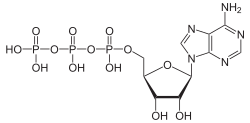ATP hydrolysis
ATP hydrolysis is a chemical reaction that involves the breakdown of adenosine triphosphate (ATP), releasing energy. ATP, a high-energy molecule, plays a crucial role in various biological processes, serving as the primary energy currency of the cell. The hydrolysis of ATP into adenosine diphosphate (ADP) and an inorganic phosphate (Pi) is a highly exergonic process, meaning it releases a significant amount of energy that is harnessed by cells to perform work, including muscle contraction, nerve impulse propagation, and chemical synthesis.
Mechanism
The mechanism of ATP hydrolysis involves the cleavage of the terminal phosphoanhydride bond in ATP. This reaction is catalyzed by a class of enzymes known as ATPases. These enzymes facilitate the reaction by lowering the activation energy, allowing the reaction to proceed rapidly and efficiently under physiological conditions. The hydrolysis reaction can be represented by the chemical equation:
ATP + H2O → ADP + Pi + Energy
The energy released during this reaction is utilized in various cellular processes, and the products, ADP and Pi, can be recycled back into ATP through the process of cellular respiration, ensuring a continuous supply of ATP for the cell.
Role in Cellular Processes
ATP hydrolysis is fundamental to a wide range of cellular activities. Some of the key processes that depend on ATP hydrolysis include:
- Muscle Contraction: ATP hydrolysis provides the energy necessary for the conformational changes in myosin molecules during muscle contraction.
- Active Transport: Many transport processes across cell membranes require energy to move substances against their concentration gradient, which is provided by ATP hydrolysis.
- Signal Transduction: ATP hydrolysis is involved in the activation and deactivation of signaling molecules, playing a critical role in cellular communication.
- Biosynthesis: The synthesis of complex molecules, such as proteins and nucleic acids, requires energy that comes from ATP hydrolysis.
Regulation
The rate of ATP hydrolysis and its coupling to energy-requiring processes are tightly regulated within the cell. Enzymes that catalyze ATP hydrolysis, such as ATPases, are subject to various regulatory mechanisms that ensure energy is not wasted and that ATP is hydrolyzed only when its energy is needed. This regulation is crucial for maintaining cellular energy homeostasis.
Clinical Significance
Disruptions in ATP hydrolysis can lead to cellular dysfunction and are implicated in a variety of diseases. For example, mutations in ATPase enzymes can result in energy metabolism disorders, affecting muscle function, nerve transmission, and other vital processes. Understanding the mechanisms and regulation of ATP hydrolysis is therefore important for developing therapeutic strategies for these conditions.
This article is a biochemistry stub. You can help WikiMD by expanding it!
Transform your life with W8MD's budget GLP-1 injections from $125.
W8MD offers a medical weight loss program to lose weight in Philadelphia. Our physician-supervised medical weight loss provides:
- Most insurances accepted or discounted self-pay rates. We will obtain insurance prior authorizations if needed.
- Generic GLP1 weight loss injections from $125 for the starting dose.
- Also offer prescription weight loss medications including Phentermine, Qsymia, Diethylpropion, Contrave etc.
NYC weight loss doctor appointments
Start your NYC weight loss journey today at our NYC medical weight loss and Philadelphia medical weight loss clinics.
- Call 718-946-5500 to lose weight in NYC or for medical weight loss in Philadelphia 215-676-2334.
- Tags:NYC medical weight loss, Philadelphia lose weight Zepbound NYC, Budget GLP1 weight loss injections, Wegovy Philadelphia, Wegovy NYC, Philadelphia medical weight loss, Brookly weight loss and Wegovy NYC
|
WikiMD's Wellness Encyclopedia |
| Let Food Be Thy Medicine Medicine Thy Food - Hippocrates |
Medical Disclaimer: WikiMD is not a substitute for professional medical advice. The information on WikiMD is provided as an information resource only, may be incorrect, outdated or misleading, and is not to be used or relied on for any diagnostic or treatment purposes. Please consult your health care provider before making any healthcare decisions or for guidance about a specific medical condition. WikiMD expressly disclaims responsibility, and shall have no liability, for any damages, loss, injury, or liability whatsoever suffered as a result of your reliance on the information contained in this site. By visiting this site you agree to the foregoing terms and conditions, which may from time to time be changed or supplemented by WikiMD. If you do not agree to the foregoing terms and conditions, you should not enter or use this site. See full disclaimer.
Credits:Most images are courtesy of Wikimedia commons, and templates, categories Wikipedia, licensed under CC BY SA or similar.
Contributors: Prab R. Tumpati, MD



